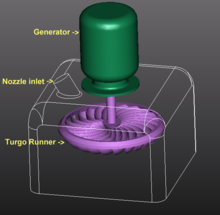
Turgo turbine
Encyclopedia

Water turbine
A water turbine is a rotary engine that takes energy from moving water.Water turbines were developed in the 19th century and were widely used for industrial power prior to electrical grids. Now they are mostly used for electric power generation. They harness a clean and renewable energy...
designed for medium head applications. Operational Turgo Turbines achieve efficiencies of about 87%. In factory and lab tests Turgo Turbines perform with efficiencies of up to 90%.
Developed in 1919 by Gilkes as a modification of the Pelton wheel
Pelton wheel
The Pelton wheel is an impulse turbine which is among the most efficient types of water turbines. It was invented by Lester Allan Pelton in the 1870s. The Pelton wheel extracts energy from the impulse of moving water, as opposed to its weight like traditional overshot water wheel...
, the Turgo has some advantages over Francis
Francis turbine
The Francis turbine is a type of water turbine that was developed by James B. Francis in Lowell, Massachusetts. It is an inward-flow reaction turbine that combines radial and axial flow concepts....
and Pelton designs for certain applications.
First, the runner is less expensive to make than a Pelton wheel. Second, it doesn't need an airtight housing like the Francis. Third, it has higher specific speed and can handle a greater flow than the same diameter Pelton wheel, leading to reduced generator and installation cost.
Turgos operate in a head range where the Francis and Pelton overlap. While many large Turgo installations exist, they are also popular for small hydro
Small hydro
Small hydro is the development of hydroelectric power on a scale serving a small community or industrial plant. The definition of a small hydro project varies but a generating capacity of up to 10 megawatts is generally accepted as the upper limit of what can be termed small hydro. This may be...
where low cost is very important.
Like all turbines with nozzles, blockage by debris must be prevented for effective operation.

Theory of operation
The Turgo turbine is an impulse type turbine; water does not change pressure as it moves through the turbine blades. The water's potential energyPotential energy
In physics, potential energy is the energy stored in a body or in a system due to its position in a force field or due to its configuration. The SI unit of measure for energy and work is the Joule...
is converted to kinetic energy
Kinetic energy
The kinetic energy of an object is the energy which it possesses due to its motion.It is defined as the work needed to accelerate a body of a given mass from rest to its stated velocity. Having gained this energy during its acceleration, the body maintains this kinetic energy unless its speed changes...
with a nozzle. The high speed water jet is then directed on the turbine blades which deflect and reverse the flow. The resulting impulse spins the turbine runner, imparting energy to the turbine shaft. Water exits with very little energy. Turgo runners may have an efficiency of over 90%.
A Turgo runner looks like a Pelton runner split in half. For the same power, the Turgo runner is one half the diameter of the Pelton runner, and so twice the specific speed. The Turgo can handle a greater water flow than the Pelton because exiting water doesn't interfere with adjacent buckets.
The specific speed of Turgo runners is between the Francis and Pelton. Single or multiple nozzles can be used. Increasing the number of jets increases the specific speed of the runner by the square root of the number of jets (four jets yield twice the specific speed of one jet on the same turbine ).

